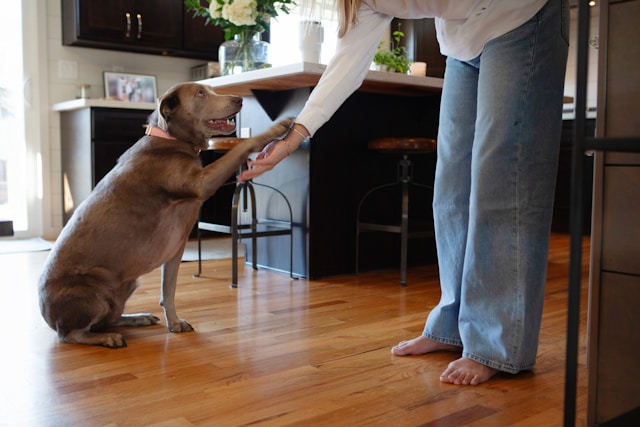Training your dog is one of the most rewarding parts of pet ownership. Not only does it help establish good behavior and improve communication, but it also strengthens the bond between you and your furry friend. Whether you’ve just brought home a puppy or adopted an older dog, learning how to teach a dog basic commands is essential for their safety, happiness, and integration into your home.
In this guide, we’ll walk through foundational techniques for dog training basics and show you how to effectively teach five key commands every dog should know.
Why Basic Commands Matter
Understanding how to train your dog isn’t just about obedience it’s about building trust. A dog who knows commands like “sit” or “stay” is easier to manage in public, safer during emergencies, and generally more confident. Puppy obedience training also sets the stage for advanced training and more complex behaviors later on.
Foundational Training Principles
Before diving into the commands, it’s important to grasp a few core principles of positive reinforcement dog training:
1. Use Positive Reinforcement
Reward your dog with treats, praise, or toys when they perform the desired behavior. This encourages them to repeat it.
2. Keep Training Sessions Short
Dogs, especially puppies, have short attention spans. Aim for 5–10 minute sessions, several times a day.
3. Be Consistent
Use the same cues and reward behaviors consistently. If you say “come” sometimes and “here” other times, your dog might get confused.
4. Minimize Distractions
Start in a quiet, familiar environment to help your dog focus. Gradually introduce distractions as they get better.
Command #1: Sit
“Sit” is often the first command taught in dog training basics, and for good reason—it’s simple and useful in nearly every situation.
How to teach:
-
Hold a treat close to your dog’s nose.
-
Slowly move your hand up, causing their head to follow and their bottom to lower.
-
Once they’re in a sitting position, say “Sit,” give the treat, and praise them.
-
Repeat this a few times daily until it becomes automatic.
When to use:
Use this command to calm your dog before walks, during feeding time, or when meeting new people.
Command #2: Stay
“Stay” is essential for control and safety, especially in busy areas or during high-energy moments.
How to teach:
-
Ask your dog to sit.
-
Hold your hand out, palm forward, and say “Stay.”
-
Take one step back. If they stay, reward them.
-
Gradually increase the distance and duration over time.
Pro tip:
If your dog moves, calmly reset without scolding. This command takes patience, but it’s a cornerstone of puppy obedience training.
Command #3: Come
Teaching your dog to come when called is a lifesaving skill. It helps you regain control during off-leash moments or if your dog bolts unexpectedly.
How to teach:
-
Start indoors or in a fenced area.
-
Crouch down, open your arms, and say “Come” in an enthusiastic voice.
-
When they arrive, reward immediately with a high-value treat.
-
Practice with increasing distance and in different environments.
Games to improve recall:
Use recall games like hide-and-seek or call-and-reward to make learning fun and effective.
Command #4: Down
“Down” helps promote calmness and is great for dogs that get overexcited.
How to teach:
-
Start with your dog in a sitting position.
-
Hold a treat in front of their nose, then slowly lower it to the ground.
-
Move the treat slightly forward to guide their body into a lying position.
-
Once they lie down, say “Down,” reward, and praise.
This command can take longer than “Sit,” so be patient and encouraging.
Command #5: Leave It
One of the most important commands for safety, “Leave it” prevents your dog from grabbing harmful items like chocolate, garbage, or sharp objects.
How to teach:
-
Show your dog a treat in your hand and say “Leave it.”
-
Close your fist if they try to take it.
-
Wait until they stop trying and look away, then reward with a different treat.
-
Progress to dropping treats or objects on the floor and repeating the process.
Use this command daily until your dog responds consistently. It’s a critical tool in responsible dog ownership.
Troubleshooting Common Challenges
Training isn’t always smooth sailing. Here are some common issues and how to address them:
-
Lack of focus: Reduce distractions or train in shorter sessions.
-
Overexcitement: Use calming techniques and avoid training right after playtime.
-
Inconsistent results: Make sure all family members use the same commands and rewards.
Consistency is key in how to train your dog effectively. It’s normal to hit roadblocks, but persistence pays off.
Tips for Long-Term Success
Training doesn’t stop after your dog learns a few commands. Keep reinforcing good behavior to maintain progress.
-
Practice in various locations: Train at home, in the park, or around other dogs to generalize the commands.
-
Gradually phase out treats: Use verbal praise or petting once the behavior is reliable.
-
Make training fun: Use toys, affection, and games to keep your dog engaged.
Training should feel like a game not a chore. The more fun you make it, the faster your dog will learn.
Conclusion
Learning how to teach a dog basic commands is an important part of becoming a confident, responsible pet owner. Commands like sit, stay, come, down, and leave it lay the foundation for good behavior, safety, and trust. Whether you’re a first-time owner or revisiting training with an older dog, positive reinforcement dog training is the most effective and humane method to achieve lasting results.

